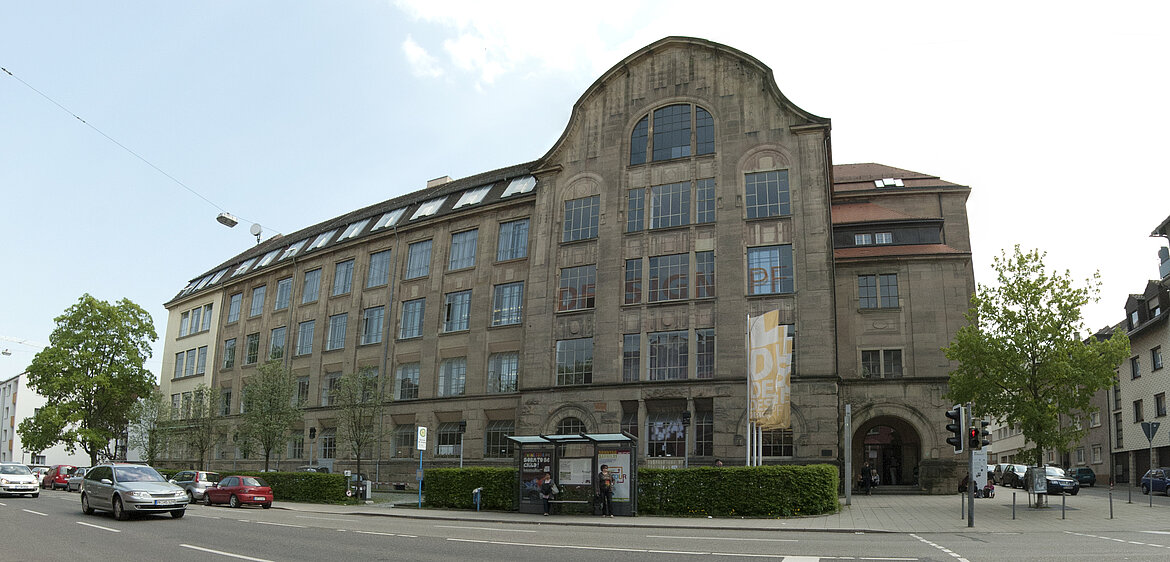Design PF History
The founding years
Today’s design faculty can look back on nearly 140 years of tradition and trace its roots to the Grand Ducal Crafts School, which was founded in 1877. At the turn of the 20th century, the students were taught in the tradition of an architectural draughtsman’s school. The curriculum ranged from shading techniques and the theory of ornamental forms to the design of crafts objects. In 1911, the school opened its newly erected Jugendstil building on Holzgartenstrasse, which presently houses the design faculty. In addition to providing more space, the new edifice was also equipped with state-ofthe- art technical apparatus, e.g. a “photographic laboratory”, and an exhibition room. The curriculum in these early years already focused on experimentation with materials and forms. Directors Friedrich Wilhelm Jochem (1912 to 1923), Anton Kling (1924 to 1927) and Otto Haupt (1927 to 1934) promoted the evolution of the crafts school into a school with numerous workshops.
1920s - 1960s
The curriculum expanded in the 1920s and 1930s to span a professional educational spectrum. The disciplines of graphic art, commercial art, decorative painting and calligraphy augmented the course of study, and individual courses explored the themes of jewellery and fashion. At the beginning of World War Two, the crafts school and the goldsmith’s school merged to create the State Master School for the German Precious Metals and Jewellery Trade. After that time, separate training in art and design was no longer possible. The aerial bombardment that destroyed the inner city of Pforzheim in 1945 also damaged the school building on Holzgartenstrasse. Large parts of the collections and facilities were obliterated. The Crafts School was renamed the School of Arts and Crafts after the war. Teaching resumed quickly thanks to collaborative efforts by students and faculty. By 1955, the student body was already larger than it had been before the war. The curriculum was broadened and new specialized departments were established. The technical division was expanded to include laboratories for electroplating and chemical engineering. The design curriculum was likewise widened. A fashion class was added: initially developed by Rosemarie Kirschner, began to acquire an international profile under the direction of Heinz Oestergaard in 1978. A class for product form, taught by the sculptor and designer Bernhard Jablonski, was added in 1964. Werner Weissbrodt began teaching a class for graphics and typefaces in 1968.
1960s - today
Beginning in 1967, students could earn degrees as designers of jewellery, utensils, surfaces (polychrome or graphic) and fashion. The curriculum was divided into three areas: design and form-giving; techniques and practices; and lectures and specialized theory. The institution was renamed “College of Design” in 1971. It offered courses of study in jewellery and utensils, graphic design, industrial design, and fashion. Students could initially earn their degrees as graduate designers. The title of “Diplom Designer (FH)” [designer with university diploma] was first conferred to graduates in 1978. Close collaboration with the automobile industry led to the establishment of motor vehicle design as a focal point for the curriculum starting in 1984. This department occupied its own building on Eutinger Strasse, which presently houses the faculty of transportation design. Accessories design was added as a new department in 2011. It and the fashion department share a building on Östliche Karl-Friedrich-Strasse, where classrooms and workshops for sewing and leatherworking are located. The College of Design and the Business College merged in 1992. Together with the newly established School of Engineering, this merger resulted in the founding of Pforzheim University – Design, Engineering, Business and Law.
Exactly 99 years after the inauguration of the building on Holzgartenstrasse, the faculty moved into a new building, the so-called “Media Tower.” As a visible link between tradition and modernity, the new edifice provides circa 1,000 square meters of floor space for media laboratories and classrooms. The School of Design in Pforzheim currently numbers among the oldest, most traditional and one of the most recognized design colleges in German-speaking Europe. First-rate workshops and media laboratories are available for use in the faculty’s various buildings. The faculty’s own library houses circa 47,000 media in the disciplines of art and design.

